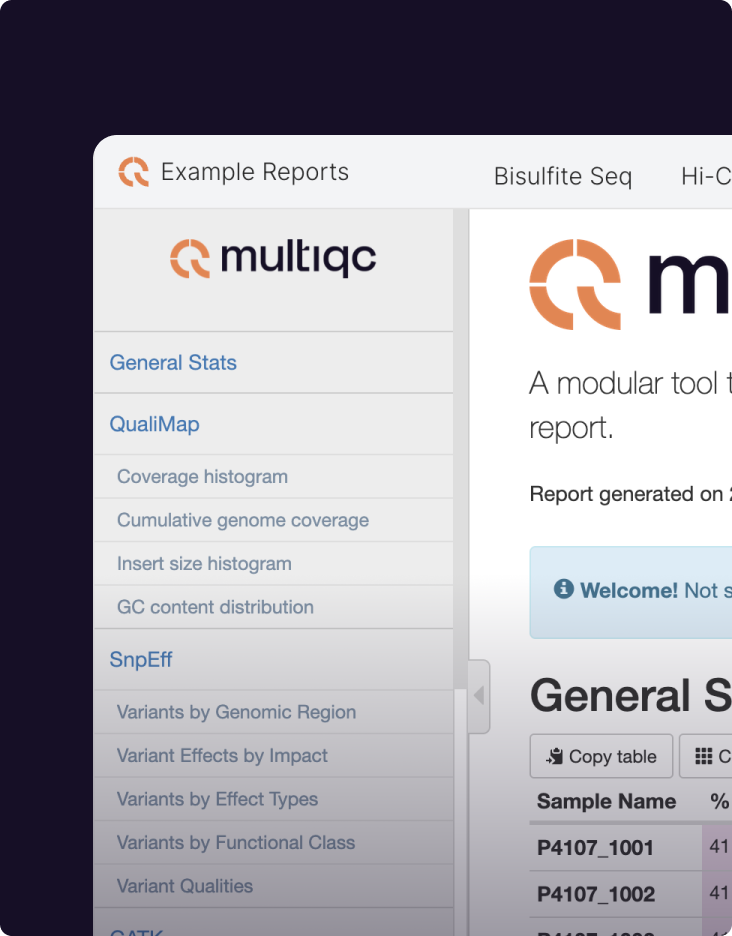MultiQC
Simplify bioinformatics analysis with a consolidated view of key quality control metrics
- pip
- conda
- docker
Are you spending hours collecting reports and wading through log file output?
Gain a holistic view of
QC metrics
With results spread across dozens or even hundreds of separate reports and log files, consolidating QC metrics is tedious and time-consuming — especially when analyzing results across multiple samples and tools.
MultiQC is an open-source project from Seqera that simplifies genomic analysis by scanning analysis directories for log files and results and presenting a single interactive summary report.
See all example reports
Sample reports
MultiQC collects numerical stats from each module at the top the report, so that you can track how your data behaves as it proceeds through your analysis.
Try with your dataThe gold standard in bioinformatics reporting
MultiQC is one of the most popular and widespread tools found in bioinformatics. It is taught in undergraduate and graduate genomics courses around the world and has become a standard fixture at the end of most biological data analysis pipelines. MultiQC has been downloaded from the Python Package index over a million times and the manuscript cited by over four-thousand articles. Someone runs MultiQC roughly approximately once every second.
Bioinformaticians and data scientists choose MultiQC because it “just works”. Its widespread adoption makes it the standard tool in the field for data visualisation and QC reporting and its built-in support of standard bioinformatics tools makes it extremely easy to use.- Simplify QC analysis across multiple tools with intuitive HTML reports and standardized outputs for downstream analysis
- Improve sample quality and the accuracy of analysis results
- Enable collaboration and boost research productivity by easily sharing QC data
- Detect outliers, anomalies, and batch effects with built-in visualizations
- Plot all your samples together, enabling detailed cross-sample comparisons without the need to look at one report at a time
- Visualize pipeline statistics in a single place and track numerical stats from each module, tracking data through the analysis process
Features
No setup required
MultiQC works out of the box, with no setup or configuration required. Data is gathered into a single interactive report, automatically extracting sample names from reports and log files for downstream analysis.
Analysts can easily scan key statistics across samples without switching files or accessing multiple QC tools.Interactive browser-based analysis
More than just a reporting tool, MultiQC provides rich visualizations, enabling analysts to explore results from multiple QC tools interactively.
Use the intuitive MultiQC interface to visualize data, sort, filter, and customize results, export visualizations to third-party tools, and visualize samples side by side.Support for 100+ tools
MultiQC automatically recognizes outputs from the most commonly used bioinformatics tools, including FastQC, Samtools, Picard, GATK, RSeQC, SnpEff, DRAGEN and many more, enabling easy analysis in a single place.
Better yet, with a vibrant, engaged open-source community and extensive documentation, the list of supported tools continues to grow, providing support for the latest tools and file formats.Built for the Seqera Platform
Built with open science in mind, MultiQC integrates seamlessly with the Seqera Platform enabling analysts in shared workspaces to easily access interactive MultiQC reports directly from the Seqera UI.
MultiQC can be used in a variety of ways and is ideally suited to being embedded as a final analysis step in analysis pipelines written in Nextflow or other workflow languages.Ready for downstream analysis
Every bioinformatics tool generates output in its own format. MultiQC standardises these, exporting data as TSV / YAML / JSON in a directory alongside the HTML report.
Data scientists can easily import data generated by MultiQC for downstream analysis, for example working with single-cell filtering based on QC metrics, or creating custom analysis reports with aggregate data.